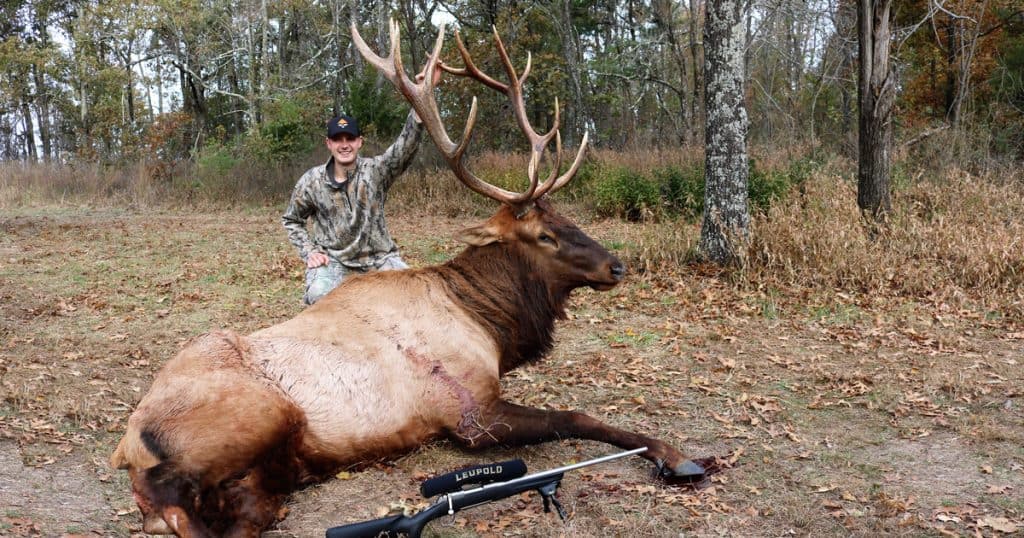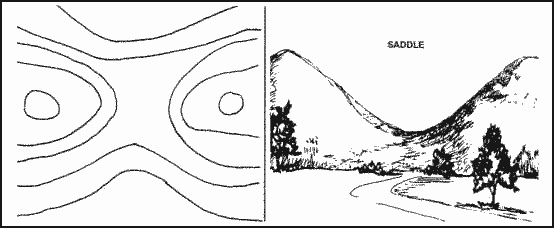We want to help you rock this season out and get the biggest bull that’s out there. That’s why we put together these 41 Elk hunting tips that are going to get you on track for your biggest hunt yet. Read them, learn them, know them, and use them. Do this and you’ll find yourself sitting behind that 6 point bull come rut season.

Scouting:
A.) Use the satellites that are already floating around. They’re already there and it’s something you can do from home before you start your scouting. With the Topographic version on Google maps, you can locate funnels and pinch points. If the forest canopy looks thinner than the rest of the forest it could also indicate grazing areas to check out!
B.) Water holes are always a good find. When you’re on the hunt check back to see if there are scrapes or fresh droppings. Also look for game trails that have ridges or saddles that funnel the elk into your ambush location.

C.) Think of scouting as having home-field advantage. If you know the lay of the land you’re going to have that much more advantage when you’re stalking a bull because you know where he’s going to be.
The Bull:
A.) A trick to try and count the points quickly to see if you got a 6×6 bull is to look how the main beam comes off the dagger tine, which is usually the 4th tine. If it comes straight back it’s probably a 5 point bull. If it comes off in a Y-shape it’s probably a 6 pointer. Make sure to actually count though if you spot a potential six, this is just a quick way to judge if you should count. Always fully count before you shoot.
B.) Stalk the bull through the lodgepoles. If you try and stalk them through the thick firs it’s just too thick. All you can see is legs and you can’t shoot at legs. So go through the lodgepoles and don’t give up. Sometimes you gotta cover miles of ground, but that’s what we’re out here for, right?
C.) Tracking elk is best at 9 a.m and later. Essentially, the elk gets kinda lazy this time and you’ll be able to get close to him without him noticing. D.) Understanding the bull’s mind is key to finding him. It’s good to know that a bull will usually bed down on little knobby hills or flats on a hill or even up the entire hill on the ridge.
E.) Older, wiser bulls won’t bed near cows during the rut season. They know better and know that predators are around. They will generally bed a few miles away where they feel safer and start bugling and moving towards the females in the morning. Don’t bother calling him, he won’t change his course. He’ll only come to you if you’re already on his trail he’s taking to the females.
F.) You can’t really tell the size of a bull by his bugle. Tiny bulls can sound like monsters and enormous bulls can whine like babies. Unless you personally know the bull, don’t guess a size by the bugle.
G.) A bull can show up to a watering hole once a day so sometimes it’s good to set up a blind spot here and just wait. This is really good if you’re not hearing any bugles and especially if it’s warm and dry.
H.) Elk really don’t like the light – they avoid it like the plague. This means they’re going to be moving the most in the evening an early morning which means you should be moving at this time too if you’re hoping to catch one.
In the morning, cover ground and try to find the elk to stalk. By evening time you want to be hunkered down into a wallow or bedding area or feeding ground. You can even camp in a spot that the elk will be walking from bedding to feeding. But after you choose your spot – wait. It takes patience to catch an elk.
I.) When it comes to bugling it’s good to know that a bull is bugling to attract cows, not other bulls. Sometimes it’s more effective to let the bull call YOU in.
Ethics:
A.) Know your range and know it well. A lot of hunters get elk at 200-400 yard ranges. If you can’t take a shot that far at a range then you can’t take a shot like that at an elk.
B.) Be a naturalist. Our ancestors were naturalists and it’s our job to continue this tradition. Immerse yourself fully into the forest of the animal and recognize the symbiotic and connectedness of nature. It will make you a better hunter.
C.) Some guys want to tote around thousands of dollars worth of equipment on their hunt to try and get a 700-yard shot. Just know – a lot can go wrong at these distances and it’s not fair to the elk to take the risk. Also, we’re here to hunt the animal. Not go on a Special Ops Seal Team Six mission to annihilate the creature.
Practice:
A.) Purposely put yourself out of your comfort zone. It’s one thing to hit the bullseye over and over on the range but another entirely when you’re in the woods and you have a 6×6 bull in front of you, you can succumb to bull fever and miss in your excitement. As true in all areas of life, you only grow and become better when you operate outside your comfort zone.
Some ideas would be to shoot on a public range, tournaments, shoot during rain, shoot with strangers, and even talk big to your friends to add mental pressure and stress when you’re at the range with them.
B.) Hunters who don’t practice their calls are going to be at a huge disadvantage. Make sure you practice and learn what it sounds like. Also, don’t call too often – the elk will catch on really quick.
C.) It’s not only important practicing shooting but also getting into a hunting position that you’re going to be watching a bull from. It’s also good to practice resting positions so you can rest quickly, efficiently, and stealthily and return to your offensive position.
Working With Guides:
A.) Maybe you need help getting set up but can’t really afford a full tour? Ya, we understand. They can be expensive. You can inquire different elk outfitters to do a drop camp service and check out prices. They’ll drive you up and drop you off and help you get a comfortable camp set up so all you have to do is show up and hunt and then come back to your camp at nightfall. Remember to shop around!
B.) If you use a guide it’s a good idea to tip them. A lot of guides will avoid this topic entirely an won’t bring it up. But if they were a good hunting partner and gave you proper guidance and direction and especially if you got an elk that they field dressed and brought it in from the field then it’s a good idea to consider tipping them. Just a considerate thought.
C.) A good guide will set up a blind spot and call the elk in about 50 yards away from you while you’re hiding behind a tree. This can be super effective, even with a friend.
D.) Always trust your guide. You will probably want to shoot the first bull you see and fill your tag. If your guide has you wait, we would advise to listen. They know the area, they’ve scouted it, they also know the bulls in the area. If you don’t listen, why’d you hire a guide?
Strategy:
A.) Keep up on the weather. If it snows you can drive out to the roads you’re hunting if they’re close. If you see fresh tracks you know there’s been movement in the area and you know when. Don’t be afraid to ask other hunters if they’ve seen tracks!
B.) You can read a bull or a cow from their tracks if you can see all 4 hoof marks. If the pee spot is in the center of the 4 tracks, you got a bull. If it’s behind the back feet, you have a cow. A bull also has wider, rounder hooves while a cow has a thinner, pointier hoof.
C.) Tracks also give you a state of mind of the elk. If the tracks are meandering and backtracking, slow down – this bull is looking to bed down. Moving single file and with purpose? You need to get moving too or you’ll lose him. Lastly, if you see debris kicked up and otherwise disturbed area then the bull probably caught wind of you and is off to bed down somewhere safe.
D.) Don’t give up if you spook the bull. Just give him an hour or so and resume tracking. You’re likely to find him again unless you spooked him from his bedding area. A bull will sometimes not return for weeks, or ever if you follow him or spook him at his bed. Just think if a predator showed up at your home. You wouldn’t feel comfortable and you probably would move. It’s natural.
E.) A bull will generally do a J-hook to go up a hill and then bed down and look to where his tracks are. It’s best to say uphill of the tracks and always be looking forward. This will keep you from getting into the line of sight of the bull.
F.) Also, don’t bother with herds that involve a ton of cows and calves. You’re just going to get spotted. More eyes and you’ll miss your prize.
G.) Get your game trail cameras out as early as June 1st. All of them. Place them at watering holes or feeding spots and start taking inventory of the bulls that show up. Remember to keep the cameras facing north or south so you don’t get your shots blinded by the sunrise or sunset.
H.) If you just want to kill an elk then you want a hard hitting rifle and that’s it. Something with flat trajectory so you can shoot from far away and know you’re going to get a hit. But – if you want to use real skill and woodsmanship then a .30/06 is the way to go. You can get a bull at 350 yards or closer. Some hunters believe if you can’t hunt your way to be within 350 yards from the bull, you don’t deserve the animal. It’s up to you to decide how you want to hunt.
On The Hunt:
A.) When the sun is first coming up you want to find yourself on top of a ridge. This is why scouting is important so you know where to go. Bugle from the top of the ridge and if you don’t get an answer back then it’s time to start covering ground and look for the bull.
B.) Sometimes elk just don’t bugle. There’s no reason why, but don’t be mistaken – they’re out there. Sit on high points and wait with binoculars. You’ll find him.
C.) When you find the bull with your binocs – move in slowly. If you bugle at a quarter mile and he responds and you suddenly bugle at 75 yards away you’ll spook him. Elk don’t move like this or this fast and neither should you. Think like the elk and move in slowly and you’ll have awesome results.
D.) During rifle season, when most hunters are present, or during extreme weather like a snow-storm even the most rut driven bulls switch into survival mode. They’ll hole up in a spot where they can eat a lot and move very little. They became the hardest animals in North America to track. If you’re determined to get after it – good luck.
General Tips:
A.) If you’re bowhunting elk a tree stand can be very effective. Elk are smart, so I would recommend getting full blinds to screen out your stand. If you’ve done you’re scouting properly it’s best to set up near a waterhole, food source, wallow, or a trail that goes from bedding to feeding.
B.) To remove elk antlers it’s actually easiest with a claw hammer. Just put the claw of the hammer to the base of the antler and position the tool to get leverage against the roof of the mouth and just pop them out like a nail.
C.) Also, sometimes forgotten is the hide. Save it. It has value and we want to try and use all the animal. Don’t worry about scraping the extra flesh or fat off of it, just freeze it or salt it to preserve it.
D.) It’s worth the money to get the best optics that you can. Sometimes the gear out there that’s cheaper is more attractive to save a few bucks but you’re going to wish you’d spent the extra money after using a cheap piece of optics out in the field for even just a couple weeks.
Elk hunting is a big stalking game and you generally spot the bull from a distance and need to move in. That’s why a good piece of glass (optics) are important. You want to have a clear image and a reliable piece of equipment that won’t let you down in the field.
E.) Make sure you wear layers when you head out. This way you can easily shed layers into your pack as it warms up and you also need to be prepared for extreme weather changes. It might be warm now, but it could be freezing in a moment. Don’t get caught with your pants down!
F.) Get a good pair of boots and we would suggest to wear them on a hike or even when you’re scouting preseason. Just get them broken in and ready to roll and you’ll thank us later.
G.) Super basic idea but still – make sure your camo fits the area your in. The stealthier you are the more effective you will be!
Game Changin’ Tactics
Now you got all the tips to take your big game hunting to the next level. Read these tips and utilize them and you’ll be well prepared for the season as it comes around. We’re excited to see the trophy bulls you bring in! Keep safe and happy hunting!
If you enjoyed this article you’ll probably like these:


